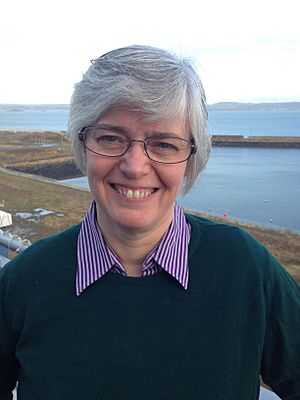Eleanor Campbell (scientist) facts for kids
Quick facts for kids
Eleanor E.B. Campbell
FRSE FRS FRSC FInstP
|
|
|---|---|
 |
|
| Born | 13 April 1960 |
| Nationality | Scottish |
| Alma mater | University of Edinburgh |
| Spouse(s) | Iain Campbell (1984–1991) Professor Mats Jonson (2003–) |
| Awards | FRSE (2004) Royal Swedish Academy of Science (foreign member) (2005) Fellow of the Royal Society of Chemistry (2008) Fellow of the Institute of Physics (2008) FRS (2010) |
| Scientific career | |
| Institutions | University of Edinburgh Freiburg University Max Born Institut University of Gothenburg |
| Thesis | Electronic to rovibrational excitation in fast atom-molecule collisions (1985) |
| Doctoral advisor | Malcolm Fluendy |
Eleanor Elizabeth Bryce Campbell, born on April 13, 1960, is a brilliant Scottish scientist. She is a professor of Chemistry at the University of Edinburgh in Scotland. She has received many important awards for her work, including being a Fellow of the Royal Society, which is a very high honor for scientists.
Contents
Becoming a Scientist: Eleanor's Education
Eleanor Campbell was born in 1960 in Rothesay, a town on the Isle of Bute in Scotland. Her parents were Isobel and William Cowan. She went to school at Rothesay Academy.
After high school, she went to the University of Edinburgh. There, she studied Chemical Physics and earned her first degree in 1980. She continued her studies at the same university for four more years. In 1986, she earned her PhD degree. A PhD is the highest university degree you can get. Her research was about how atoms and molecules interact at very high speeds.
After her PhD, she moved to the University of Freiburg in Germany. There, she worked as an assistant professor in experimental physics.
Eleanor Campbell's Career Journey
After her time in Germany, Professor Campbell became a leader in science. In 1993, she became a department head at the Max-Born Institut. This is a research center that studies very fast processes in physics.
In 1998, she moved to Sweden. She became the Chair of Atomic and Molecular Physics at the University of Gothenburg. A "Chair" means she was a leading professor in that field.
Later, in 2007, she returned to the University of Edinburgh. She became the Chair of Physical Chemistry. Then, in 2013, she became the Chair of Chemistry. This means she leads the chemistry department at the university.
Awards and Recognitions
Professor Campbell has been recognized for her amazing contributions to science.
- In 2004, she was chosen as a Fellow of the Royal Society of Edinburgh.
- In 2005, she became a Foreign Member of the Royal Swedish Academy of Sciences. This is a special honor for scientists from other countries.
- In 2008, she was made a Fellow of the Royal Society of Chemistry and a Fellow of the Institute of Physics.
- In 2010, she was elected a Fellow of the Royal Society. This is one of the oldest and most respected scientific organizations in the world. She received this honor for her important discoveries about how excited molecules behave.
- In 2018, she was also elected as a member of the Academia Europaea.
What Eleanor Campbell Studies Now
Professor Campbell and her team at the University of Edinburgh are always working on exciting new research.
- They use very fast lasers, called femtosecond lasers, to study how complex molecules become charged. They also look at how these molecules change when they are in an "excited state."
- Her group also studies tiny materials made of carbon, called carbon nanomaterials.
- They are also developing special carbon-based materials that have tiny holes. These materials can be used to capture and store gases, which is important for environmental protection.

